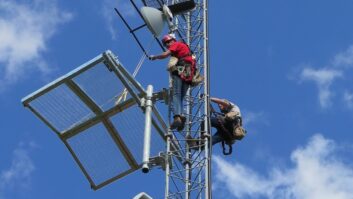
Digital Radio Mondiale Chairman Ruxandra Obreja
LONDON — If digital is so advantageous, then why is the digitization of radio broadcasting taking such a long time to establish itself across the globe?
The answer has been demonstrated very recently in the United Kingdom, where the latest official RAJAR figures show that 56.6 percent of listening is on analog (FM/AM), while two-thirds of new receivers bought are still analog-only. In other words, spectrum- and energy-hungry FM, and even the sometimes declared “dead” AM are still going strong. What analog has in spades is a lot of varied national, regional and local programming as well as universally cheap receivers.
COMPLEMENTARY SERVICES
None of the three internationally recognized digital audio broadcasting standards (Digital Radio Mondiale, DAB/DAB+ and HD Radio) can singly deliver all the perceived advantages of analog, which continues to pile on the pressure despite its nonagenarian status.
Spectrum squeeze also poses problems — recently, the European Broadcasting Union had to take position and defend the old analog television band against the grab tactics of DTT, which is enviously eying Band III (also the home of DAB) while the pressure on UHF continues unabated.
So caught in a vise by analog on one side and digital TV on the other, with the added noise about the (limited) advantages of IP, of satellite and other platforms in delivering sound broadcasting, where is audio broadcasting or radio heading?
It is no surprise that the answer is digital — for all the reasons that have been so well rehearsed. Digital radio provides enhanced audio for both FM and AM (DRM alone does it in all frequency bands above and below 30 MHz), more content and programs (up to three or four programs in DRM vs. only one FM or AM program now), additional opportunities for public service and niche broadcasting and opportunities to target new audiences.
What’s more, the above advantages come with significant energy consumption reductions (DRM uses up to 80 percent less energy than the average analog transmitter) and a better use of spectrum. To this can be added new business opportunities, the real marketplace growth potential and a growth path for advertisers. Does that mean all is sorted then? Not quite, as there are still discussions about the best standard that could deliver the greatest benefits.
From the DRM perspective, if a country’s coverage is mainly on the longwave, medium-wave or shortwave bands, then the DRM standard can offer a much better listening experience in terms of quality, reliability and additional features, such as stereo or multi-language programming.
JOINT SUITABILITY
The sound quality from the digital radio DRM30 system is such that the subjective listening experience on a small home radio or car radio is close or even better than that of an FM service.
India’s decision to invest in DRM30 to replace the AM transmission network represents therefore a highly laudable technical decision as medium-wave broadcasting networks using DRM30 will provide optimum coverage with excellent sound quality, making “FM-like” radio available to hundreds of millions of people.
Smaller, mainly European countries, like Norway or the U.K. feel that the multiplex solution suits them best. But for many other countries it will not be a case of either/or but both DRM and DAB, the open standards that are genetically similar, in effect “digital cousins.”
There are even those in countries like South Korea, South Africa and Turkey asking about joint suitability. In many nations DRM+ — the DRM mode for digitizing Bands I, II (FM) and III — could be an easy digital path for FM commercial local and community stations, either on their own or in conjunction with the large digital multiplexed stations.
Having a combined receiver DRM and DAB+ would also offer benefits to manufacturers such as for example being able to use the same COFDM transmission, codec (even though DRM has recently progressed to the extended efficiency of AAC), data applications (text, traffic information, slideshow), service signaling, disaster warning/alert features and well-aligned receiver profiles.
For listeners this would mean that they get a seamless radio experience no matter which standard is being used on a receiver that has the ability to retune across DRM/DAB/FM and AM networks.
LISTENER FIRST
At the moment it seems that with three standards out in the market the digital decision is being taken not so much by governments but by chipset manufacturers. Some of them are going for the full multistandard digital (and analog) chipset mainly at the request of the automotive manufacturers. It seems that cars can accommodate (immediately or potentially) more than one standard on their dashboard. And then the new in-car digital receiver seems cheap when compared not just with the analog receiver but also with the total cost of the car itself.
“Driven” by the automotive industry, by the interest in data provision, by the availability of sound on tablets and PAD, digital radio is coming. But will it be with one standard or a combination of standards?
This is a discussion for technical seminars. Listeners do not care about acronyms. The technology or technologies that will eventually gain the upper hand will be those that can demonstrate the most robust, global performance. Do not expect this match to be over in two or three rounds.
Ruxandra Obreja is chairman for Digital Radio Mondiale.
Radio World welcomes other points of view. Please send comments to [email protected].












